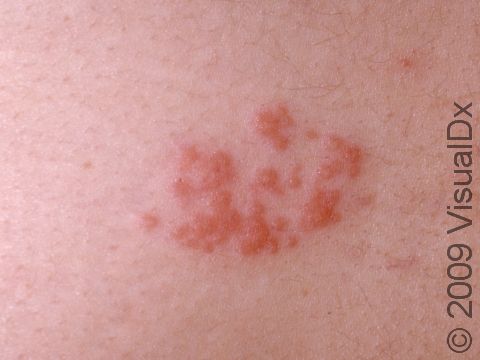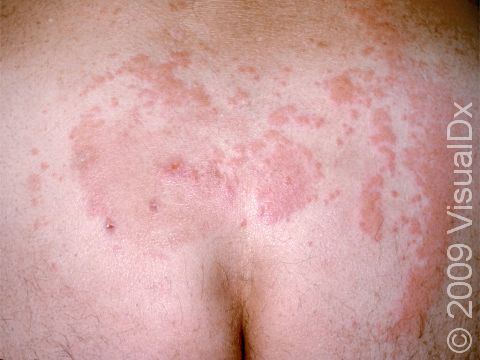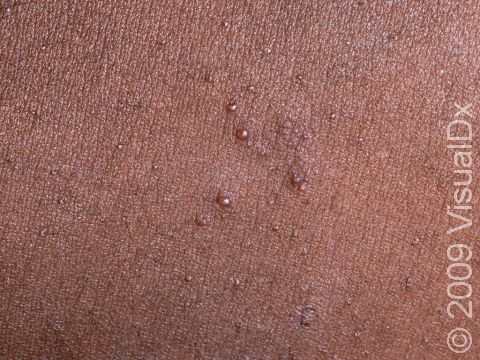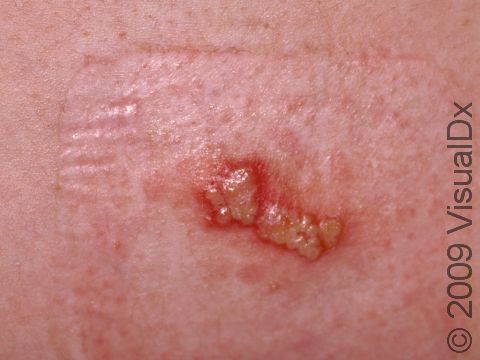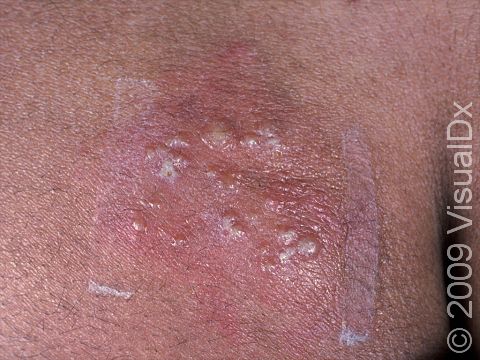Sacral Herpes
Herpes simplex infection of the lower back and buttocks, also called sacral herpes simplex or genital herpes, is a common recurrent skin condition associated with infection by the herpes simplex virus (HSV). HSV infection usually appears as a group of small vesicles (fluid-filled blisters), erosions (sore areas of missing skin), or crusts (scabs) around the mouth, nose, genitals, buttocks, or lower back, although infections can develop almost anywhere on the skin.
Infections with HSV are very contagious and are spread by direct contact with the skin lesions. There are 2 types of HSV: herpes simplex virus type 1 (HSV-1) and herpes simplex virus type 2 (HSV-2). HSV-1 is the most common cause of infections around the mouth, lips, nose, and face, although HSV-2 can also be a cause, and HSV-2 more commonly causes lesions on the genitals. Both HSV-2 and HSV-1 can cause infections on the genitals, lower back, and buttocks.
Both types of herpes simplex virus produce 2 kinds of infections: primary and recurrent. HSV causes a primary infection in most people who are exposed to the virus. Appearing 5-7 days after a person’s first exposure to HSV, the sores of a primary infection last about 2-4 weeks. These sores heal completely, rarely leaving a scar. Affected individuals carry the virus in their bodies for the rest of their lives.
Certain triggers can cause the hibernating (latent) virus to wake up, become active, and travel back to the skin. These recurrent herpes simplex virus infections may develop frequently (every few weeks), or they may never develop. Recurrent infections tend to be milder than primary infections and generally occur in the same location as the primary infection.
Sacral herpes is a form of genital herpes. Many people who have it may think they have a recurrent skin condition such as shingles, a yeast infection, or an allergic reaction instead.
Who's At Risk?
HSV infections occur in people of all races / ethnicities, ages, and sexes. Sexually active teenagers and adults, who contract it from their sexual partners, are commonly affected. Newborns can also contract it during childbirth.
The majority of people with HSV infections have not been diagnosed and are unaware of their condition. Nevertheless, they can still transmit the infection to others (called asymptomatic shedding).
Signs & Symptoms
The most common locations for sacral HSV include:
- The lower back.
- One or both buttocks.
In women, other locations for genital herpes infection include:
- External genitalia.
- Labia majora and minora.
- Vagina.
- Cervix.
- Around the anus.
In men, other locations for genital herpes infection include:
- Head and shaft of penis.
- Scrotum.
- Thighs.
- Around the anus.
Shortly after exposure to the virus, a newly infected person may develop vesicles or pustules, occurring singly or in a group. These vesicles and pustules are usually quite fragile, so people may never notice them but instead see tiny erosions. These painful erosions subsequently become scabbed over. The scabs eventually fall off, leaving a red or hyperpigmented (darker) area that finally fades. The primary outbreak typically lasts 2-4 weeks.
In mild cases of primary HSV infection, an individual may develop 1 or 2 lesions or may notice no symptoms at all. The lymph nodes in the groin may or may not be swollen. In severe cases of primary HSV infection, people may develop fever, headache, muscle pain, painful urination, and discharge from the vagina or urethra.
Recurrent HSV infections are often milder than the primary infection, but they look similar. However, some people never develop the symptoms of a primary HSV infection and may mistake a recurrent infection for a primary infection. A recurrent infection typically lasts 7-10 days. People who are prone to recurrent outbreaks tend to get them 3-4 times per year.
Many people with recurrent sacral herpes infections report that the skin lesions are preceded by sensations of burning, itching, or tingling (called prodrome symptoms). About 24 hours after prodrome symptoms begin, the actual lesions appear as one or more small blisters or open sores, which eventually become scabbed over.
Triggers of recurrent HSV infections include:
- Fever or illness.
- Sun exposure.
- Hormonal changes, such as those due to menstruation or pregnancy.
- Stress.
- Trauma (eg, a cut).
- Surgery.
- Friction to the area (eg, caused by sexual intercourse or tight-fitting clothes).
Self-Care Guidelines
Acetaminophen (Tylenol) or ibuprofen (Advil, Motrin) may help reduce fever, muscle aches, and pain caused by the HSV sores. Applying cool compresses or ice packs may relieve some of the swelling and discomfort. Wearing loose-fitting clothes can help avoid irritation to your skin.
Because HSV infections are so contagious, it is important to take the following steps to prevent spread (transmission) of the virus during the prodrome phase (burning, tingling, or itching) and active phase (presence of blisters or sores) of HSV infections:
- Avoid sharing towels and other personal care items.
- Wash your hands with soap and water if you touch an active lesion.
- Avoid sexual contact (including oral, vaginal, and anal sex) during both the prodrome phase and the active phase.
Unfortunately, the virus can still be transmitted even when someone does not have active lesions. Therefore, practice safer sex practices such as using a condom between outbreaks, even if no sores are present on the lower back, buttocks, or genitals.
Treatments
Most HSV infections are easy for medical professionals to diagnose. On occasion, however, a swab from the infected skin may be sent to a laboratory for viral culture, which takes a few days to grow. Blood tests may also be performed.
Untreated HSV infections will go away on their own, but medications can reduce the symptoms and shorten the duration of outbreaks. There is no cure for herpes.
Treatment for primary HSV infection includes oral antiviral medications such as acyclovir (Zovirax), valacyclovir (Valtrex), and famciclovir (Famvir).
Treatment for recurrent HSV infection includes the same oral antiviral medications.
People who experience prodromes before recurrent infections may benefit from episodic treatment by starting to take medication after the onset of tingling and burning but before the appearance of blisters and sores.
Other people have recurrent infections that are frequent enough or severe enough to justify suppressive therapy, where medications are taken every day to decrease the frequency and severity of attacks.
Visit Urgency
If you develop tender, painful sores on the lower back or buttocks, see a medical professional as soon as possible because treatment is much more effective if started early. If you have a recurring rash on your lower back or buttocks, even if you think it is from bug bites, ingrown hairs, or any other condition, see a medical professional to confirm the diagnosis.
Recurrent outbreaks rarely require immediate medical attention.
If you have an underlying medical condition such as cancer or HIV, if you have undergone organ transplantation, or if you are pregnant, you are at higher risk for more serious complications from HSV infection. Seek medical advice as soon as possible, especially if you are at high risk for complications.
Trusted Links
References
Bolognia J, Schaffer JV, Cerroni L. Dermatology. 4th ed. Philadelphia, PA: Elsevier; 2018.
James WD, Elston D, Treat JR, Rosenbach MA. Andrew’s Diseases of the Skin. 13th ed. Philadelphia, PA: Elsevier; 2019.
Kang S, Amagai M, Bruckner AL, et al. Fitzpatrick’s Dermatology. 9th ed. New York, NY: McGraw-Hill Education; 2019.
Last modified on July 11th, 2025 at 12:12 pm

Not sure what to look for?
Try our new Rash and Skin Condition Finder
